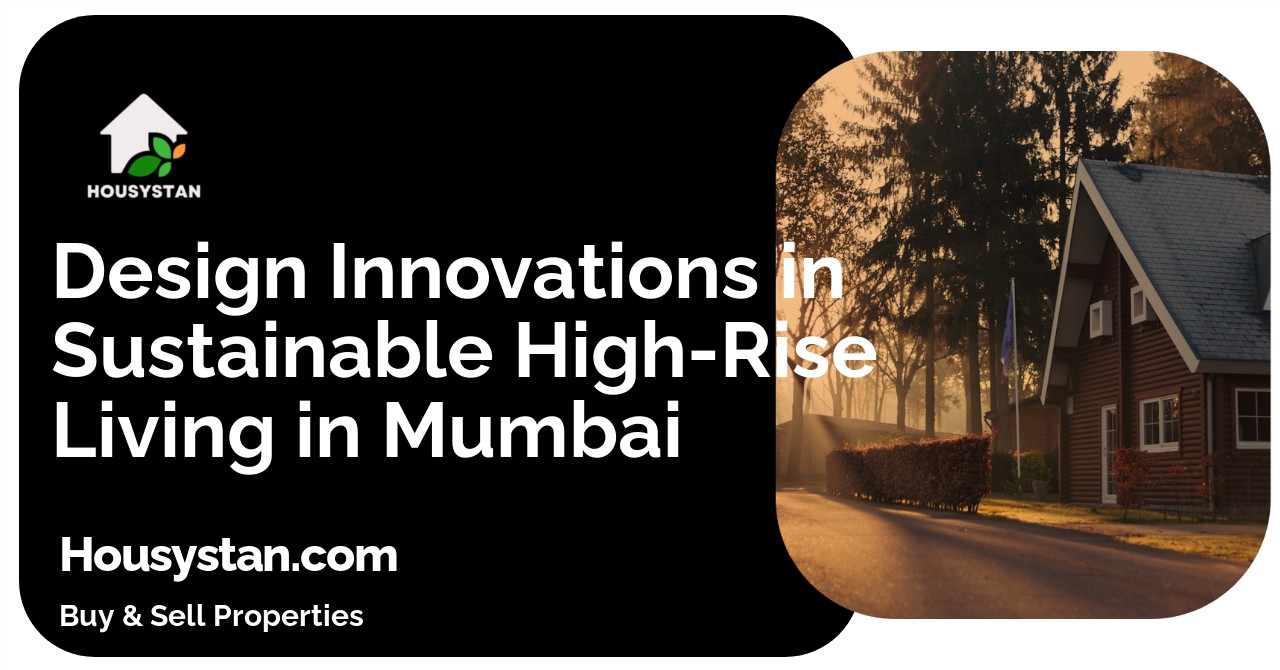Design Innovations in Sustainable High-Rise Living in Mumbai
Read latest blogs and articles from Housystan

The Information mentioned here was last updated on:
27/11/2025Design Innovations in Sustainable High-Rise Living in Mumbai
Embracing the Green Revolution in High-Rise Living
Mumbai, known for its bustling streets and towering skyscrapers, is at the forefront of a sustainable revolution in high-rise living. With a population that continues to grow, the need for environmentally friendly homes is more crucial than ever. Developers and architects in Mumbai are pioneering innovative ways to make high-rise buildings more sustainable, ensuring they meet the needs of today without compromising the future.
- Verified Tenants/Buyers
- Unlimited Property Listing
- Zero subscription/charges fee
Green Architecture: Building with Nature in Mind
Green architecture is reshaping Mumbai’s skyline. This approach involves designing buildings that work harmoniously with the environment. It incorporates natural light, ventilation, and greenery into the living spaces, creating healthier and more sustainable homes.
1. Vertical Gardens and Green Walls: One of the most visual indicators of this trend, vertical gardens and green walls, are common in newly developed buildings. They help improve air quality, reduce the urban heat island effect, and enhance the building's aesthetic appeal.
2. Biophilic Design: This concept focuses on the connection between humans and nature. By integrating natural elements like plants and sunlight into living spaces, these buildings provide psychological benefits and promote well-being.
The Role of Technology in Sustainable High-Rises
Technology plays a pivotal role in enhancing the sustainability of high-rise buildings in Mumbai. Smart buildings equipped with various technological advancements are becoming the norm.
1. Energy-Efficient Systems: High-rise buildings are now equipped with energy-efficient heating, ventilation, and air conditioning (HVAC) systems. These systems significantly reduce energy consumption, leading to lower carbon footprints.
2. Automation and Smart Controls: Smart technologies are implemented to optimize energy use. This includes automated lighting systems, climate control, and water management systems, all designed to minimize waste and maximize efficiency.
Water Conservation: A Precious Resource in High Demand
Water scarcity is a pressing issue in Mumbai, and high-rise buildings are leading the way in water conservation efforts. Developers are now integrating water-saving technologies to reduce consumption and enhance sustainability.
1. Rainwater Harvesting: Many high-rise buildings incorporate systems to collect and store rainwater. This harvested water can be used for landscape irrigation, flushing toilets, and other non-potable uses, reducing the dependence on municipal water supplies.
2. Greywater Recycling: Recycling greywater—water from baths, sinks, and washing machines—is another method being used. With proper treatment, this water can be reused for various purposes, significantly cutting down on fresh water demand.
Renewable Energy Sources: Powering the Future
To reduce reliance on non-renewable energy, many of Mumbai’s high-rises are tapping into renewable energy sources. Solar panels and wind turbines are increasingly common on rooftops and facades, transforming buildings into energy producers.
1. Solar Power: Solar panels convert sunlight into electricity that can power common areas and appliances within the building. This not only reduces electricity costs but also contributes to cleaner power.
2. Wind Turbines: On some taller structures, small-scale wind turbines harness wind energy, complementing solar power in making the building self-sufficient in energy.
Sustainable Building Materials: Strength Meets Sustainability
Sustainability starts from the ground up, literally. The materials used in the construction of high-rise buildings in Mumbai are carefully selected to reduce environmental impact.
1. Recycled and Locally Sourced Materials: Using materials that are recycled or sourced locally not only reduces transportation emissions but also supports local industries. This includes recycled steel and concrete, which form the backbone of these high-rises.
2. Low-Emitting Materials: To ensure higher indoor air quality, low-emitting materials are used for paints, finishes, and furnishings. These materials release fewer volatile organic compounds (VOCs), creating healthier indoor environments for residents.
Community Spaces: Nurturing a Sense of Belonging
Community spaces are integral to sustainable high-rise living, as they foster social interaction and enhance quality of life. Mumbai’s new developments are incorporating diverse communal areas to bring people together.
1. Rooftop Gardens and Parks: High-rise rooftops are often converted into garden spaces, providing residents with a green refuge amidst the urban hustle. These spaces also serve as communal areas for recreation and social gatherings.
2. Shared Amenities: Shared amenities such as gyms, swimming pools, and event halls encourage a sense of community. By sharing resources, residents reduce individual consumption and promote sustainability.
Adapting to Climate Change: Resilience is Key
Mumbai’s high-rises are not only built for sustainability but also for resilience. Climate resilience ensures that buildings can withstand the impacts of extreme weather events, a necessity given Mumbai’s vulnerability to climate change.
1. Flood-Resistant Design: With the risk of flooding, high-rises incorporate elevated foundations and advanced drainage systems to withstand heavy rainfall and rising water levels.
2. Heat-Resistant Facades: Innovations in facade materials have led to the development of heat-resistant exteriors that reduce the demand for air conditioning, keeping energy use low even during the hot summer months.
A Vision for the Future: The Path Forward
If Mumbai’s high-rises continue to evolve along these sustainable lines, the city will likely become a global leader in eco-friendly urban living. With each new building, developers are learning to push the boundaries of what's possible, integrating more efficient designs and cutting-edge technologies to curate living spaces that are in tune with both people and the planet.
The ongoing innovations in design, technology, and materials not only enhance the quality of life for residents but also preserve Mumbai’s environment for future generations. Developers, architects, and city planners must continue to collaborate and innovate, ensuring that Mumbai grows sustainably vertical without losing its ecological balance.
The rise of sustainable high-rises in Mumbai represents a beacon of hope, showcasing how megacities can flourish without sacrificing environmental integrity. With ongoing advancements, these buildings will continue to redefine urban living, harmonizing growth with sustainability in one of the world’s busiest cities.